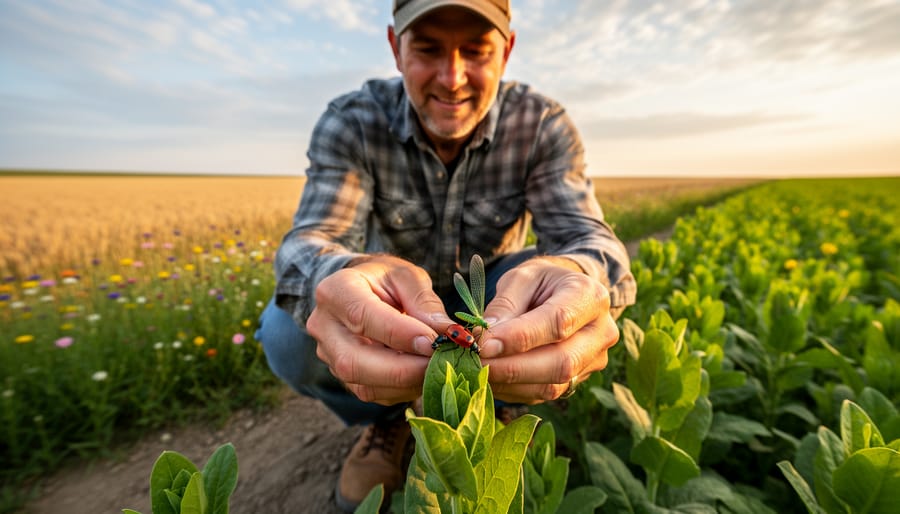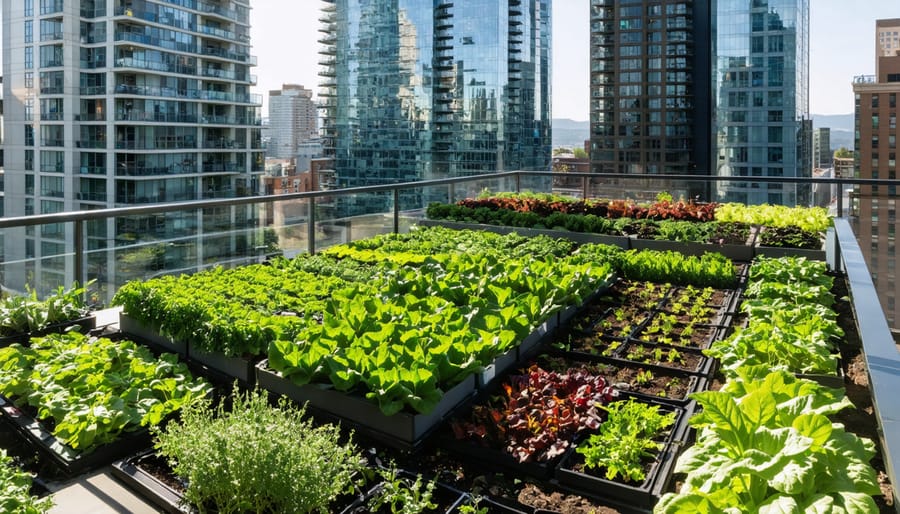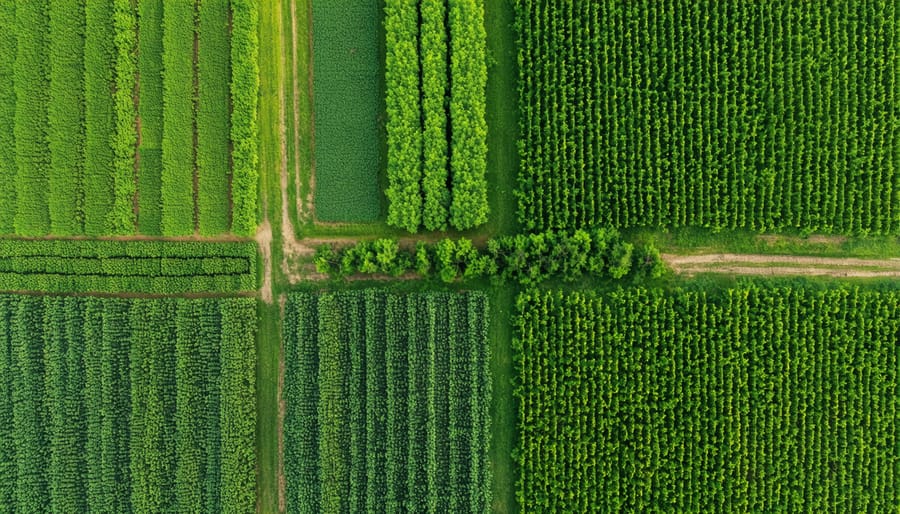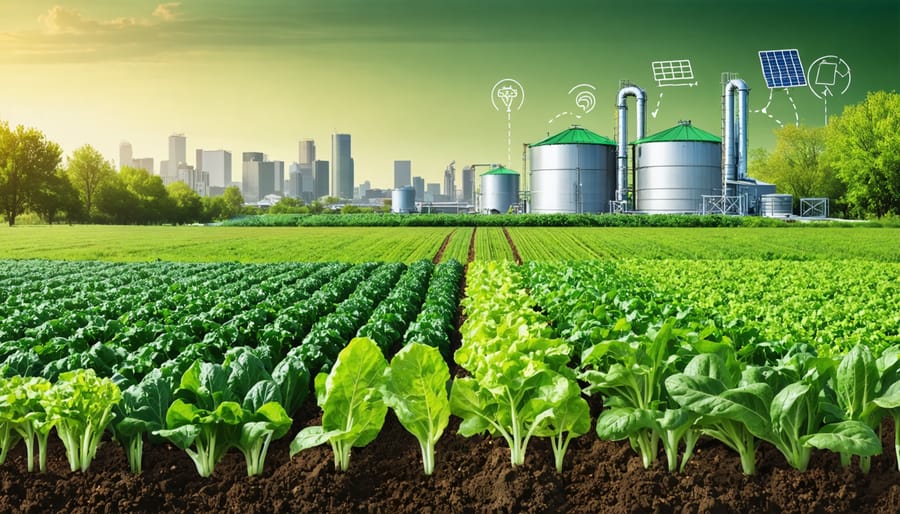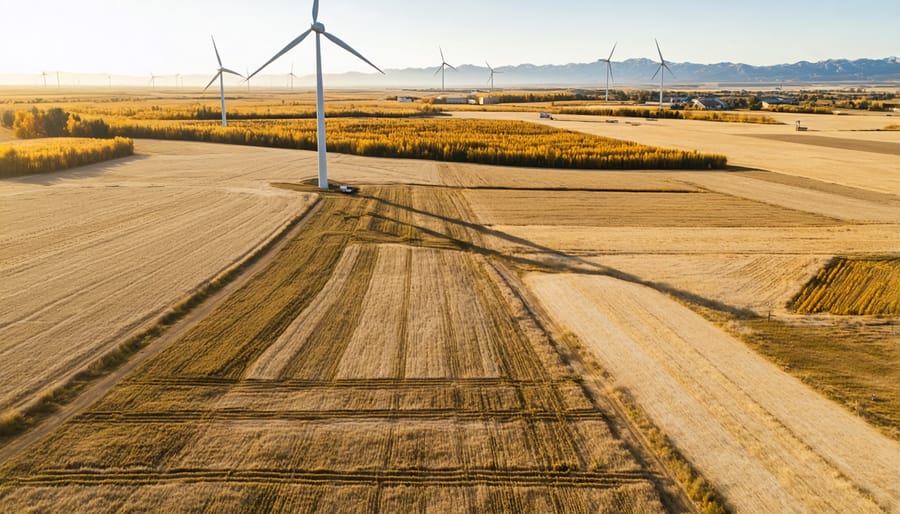Transform depleted soil into a thriving ecosystem by incorporating biochar at 10-20 tonnes per hectare, a practice that’s revolutionizing Alberta’s agricultural landscape. This ancient soil amendment technique, now backed by modern science, locks carbon into the ground for centuries while boosting crop yields by up to 40% in challenging Prairie conditions. Mixed with composted manure and beneficial microorganisms, biochar creates a powerful soil enhancement system that dramatically improves water retention, reduces fertilizer requirements, and builds long-term soil health. Canadian farmers pioneering biochar applications have reported significant improvements in drought resistance and soil structure, particularly in sandy or clay-heavy soils common across the Prairie provinces. As global agricultural challenges mount, biochar stands out as a practical, proven solution for sustainable farming that simultaneously addresses climate concerns while enhancing farm productivity and profitability.
What Makes Biochar a Game-Changer for Alberta Farms
The Science Behind Soil Enhancement
When biochar is incorporated into farmland, it initiates a remarkable transformation of soil structure and biodiversity. The porous nature of biochar creates a vast network of microscopic spaces that serve multiple functions in the soil ecosystem. These tiny cavities act like microscopic apartment buildings, providing homes for beneficial microorganisms while simultaneously improving water retention and nutrient availability.
The science behind biochar’s effectiveness lies in its unique physical and chemical properties. Its high surface area, typically ranging from 300-500 square metres per gram, allows it to adsorb and hold essential nutrients that would otherwise leach away during rainfall. This characteristic is particularly valuable for Alberta’s varied climate conditions, where nutrient retention can be challenging.
Moreover, biochar’s stable carbon structure persists in soil for hundreds to thousands of years, making it an excellent tool for long-term soil improvement. Research conducted at Canadian agricultural stations has shown that biochar-amended soils typically maintain 20-40% higher moisture content and demonstrate improved cation exchange capacity, which enhances the soil’s ability to store and exchange vital plant nutrients.
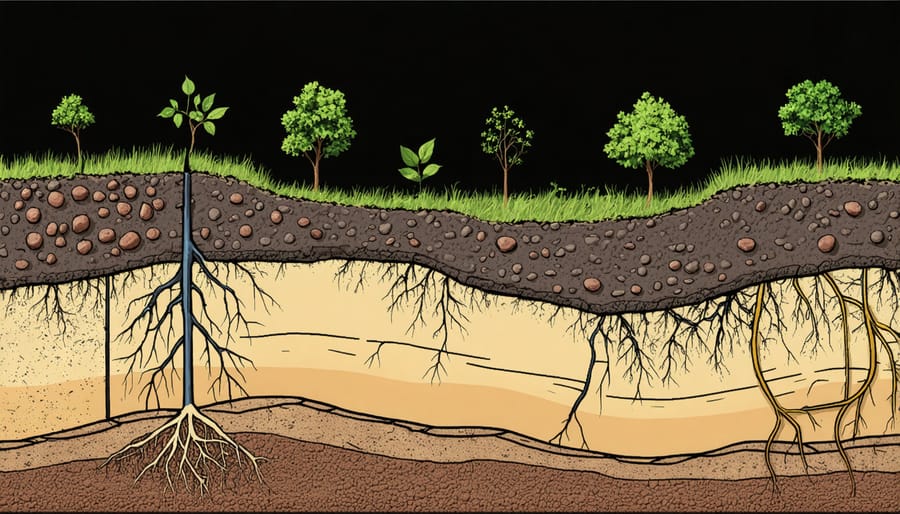
Carbon Storage Benefits
Biochar stands out among carbon sequestration methods for its remarkable ability to lock carbon away for hundreds, even thousands of years. When you incorporate biochar into your soil, you’re not just improving your farm’s productivity – you’re actively fighting climate change. Every tonne of biochar can sequester about 2.5 tonnes of CO2 equivalent, making it a powerful tool for reducing greenhouse gas emissions.
Here in Alberta, where our agricultural sector is increasingly focused on sustainability, biochar offers a practical way to offset farm emissions while building soil health. Local studies show that biochar-amended soils maintain their carbon content significantly longer than those treated with conventional organic matter. What’s particularly encouraging for our farming community is that biochar’s porous structure doesn’t just store carbon – it also helps retain water and nutrients, creating a win-win situation for both climate action and crop productivity.
Think of biochar as a long-term investment in your soil’s carbon bank, one that pays dividends through improved soil structure and enhanced ecological resilience.
Practical Application Methods for Canadian Farms
Application Rates and Timing
Application rates for biochar vary depending on your crop type and soil conditions, but for most Alberta farms, we recommend starting with 5-10 tonnes per hectare. For grain crops like wheat and barley, aim for the lower end of this range, while vegetable gardens and high-value crops may benefit from rates up to 20 tonnes per hectare.
Timing is crucial for optimal results. Apply biochar in early spring or fall when soil conditions are workable. For spring applications, incorporate the biochar at least two weeks before planting to allow proper soil integration. Fall application gives the biochar time to weather naturally over winter, potentially improving its effectiveness for the following growing season.
Sandy soils typically benefit from higher application rates (8-10 tonnes/ha) to improve water retention, while clay-rich soils may need less (5-7 tonnes/ha) to enhance drainage and aeration. For market gardens and smaller plots, apply approximately 1-2 kg per square metre.
Before application, charge your biochar by mixing it with compost or manure at a 1:1 ratio and letting it rest for 2-4 weeks. This pre-treatment helps the biochar absorb nutrients and beneficial microorganisms. Incorporate the charged biochar into the top 15-20 cm of soil using standard tillage equipment or a disc harrow.
Remember that biochar is a one-time application that provides long-term benefits, so it’s better to start conservative and monitor results before increasing application rates.
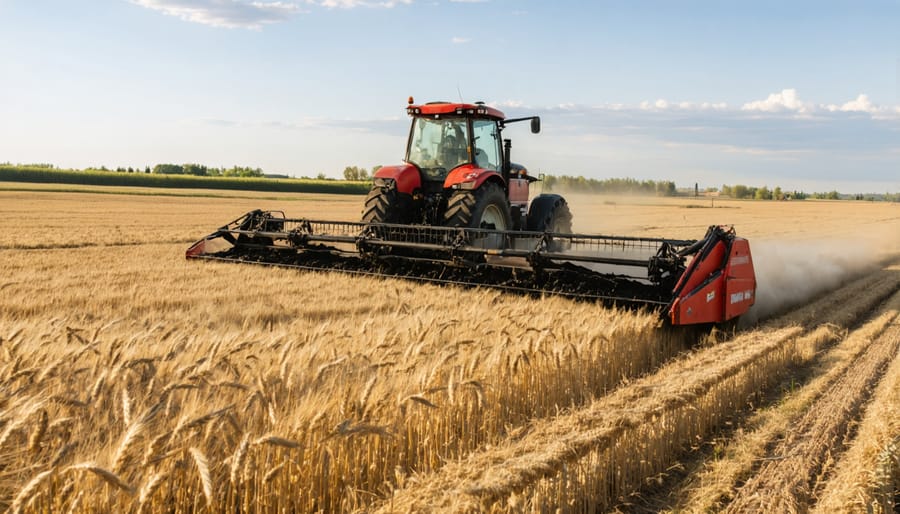
Equipment and Integration
Integrating biochar into your farming operation requires careful consideration of both equipment and application methods. For small-scale operations, basic tools like shovels, rakes, and wheelbarrows are sufficient for manual application. Medium-sized farms often use conventional spreaders or manure applicators, which can be easily adapted for biochar distribution.
Larger operations typically employ specialized equipment such as pneumatic applicators or modified lime spreaders. These machines help achieve even distribution and can be calibrated for precise application rates, typically ranging from 2 to 10 tonnes per hectare. Many Alberta farmers have found success using their existing seed drills or air seeders with minor modifications to handle biochar particles.
To minimize dust during application, it’s recommended to slightly moisten the biochar or apply it during low-wind conditions. Some farmers combine biochar application with other field operations by mixing it with compost or incorporating it during tillage, making the process more efficient.
For integration into existing systems, consider:
– Using feed mixers for combining biochar with compost
– Incorporating biochar through irrigation systems (requires fine filtration)
– Adding biochar to seed rows during planting
– Blending with existing soil amendments
Many successful Canadian operations have developed custom solutions, such as modified grain augers or spreader attachments. These adaptations often prove more cost-effective than purchasing specialized equipment. When starting out, experiment with smaller areas using available equipment before scaling up to larger implementations.
Always ensure proper safety measures, including dust masks and eye protection, particularly when handling dry biochar. Equipment should be thoroughly cleaned after use to prevent residual buildup and maintain optimal performance.
Real Results from Alberta’s Fields
Crop Yield Improvements
Research across various Canadian farms has shown significant yield improvements when biochar is properly integrated into organic farming practices in Alberta and beyond. In recent field trials, canola crops demonstrated a 15-20% increase in yield when biochar was applied at 10 tonnes per hectare. Similar success has been observed with wheat, where yields improved by 12-18% under comparable conditions.
Local farmers have reported particularly impressive results with root vegetables. Potato yields increased by up to 25% in sandy soils amended with biochar, while carrot production showed a 20% improvement in overall marketable crop. These results were most pronounced in areas with historically poor soil structure.
Berry farmers in British Columbia have documented 15-30% increases in strawberry and raspberry yields, with the added benefit of improved fruit quality and shelf life. Market gardeners growing mixed vegetables have noted that biochar-amended plots consistently outperform control areas, especially during periods of moisture stress.
The most substantial improvements typically occur in the second and third years after application, as biochar continues to enhance soil structure and nutrient retention. Fields treated with biochar also show greater resilience during drought conditions, maintaining yields when conventional fields experience significant drops in productivity.

Economic Benefits
The economic benefits of biochar implementation present a compelling case for Canadian farmers looking to enhance their long-term profitability. Recent studies from Alberta agricultural research stations show that initial investments in biochar typically range from $500 to $1,200 per hectare, depending on application rates and source materials.
While the upfront costs may seem substantial, farmers report significant returns within 2-3 growing seasons. A 2022 case study from Red Deer County documented a 15-20% increase in crop yields, translating to approximately $300-400 additional revenue per hectare annually. When combined with reduced fertilizer needs, typically 30% less than conventional applications, the cost savings can reach $150-200 per hectare each year.
Local farmer Mike Thompson from Lacombe shares, “After our initial biochar investment three years ago, we’ve seen our soil amendment costs drop by 25%, while our yield consistency has improved, especially during dry seasons.” The durability of biochar means these benefits persist for multiple growing seasons, extending the return on investment.
Carbon credit opportunities through Alberta’s carbon offset program provide additional revenue streams, with biochar applications potentially qualifying for $30-45 per tonne of CO2 equivalent sequestered. When factoring in all economic benefits, including reduced irrigation needs and improved soil structure, most farmers achieve full ROI within 3-4 years, with continued benefits for decades to come.
Sourcing and Production Options
Local Suppliers and Resources
For those looking to incorporate biochar into their sustainable agricultural practices, several Canadian suppliers and resources are readily available. In Alberta, Blue Rock Biochar (Calgary) and Prairie Biochar (Edmonton) offer both bulk and retail quantities, with delivery options across Western Canada.
The Canadian Biochar Network maintains an up-to-date directory of certified suppliers and testing facilities. Key support services include the Alberta Biochar Initiative, offering technical consultation and workshop opportunities for farmers.
For equipment needs, Canadian Biomass Solutions (Manitoba) provides specialized biochar spreading equipment rentals and custom application services. The University of Alberta’s Agricultural Research Station offers soil testing services specifically calibrated for biochar applications.
Local agricultural extension offices throughout Alberta provide free consultations and can connect farmers with regional biochar experts. Additionally, the Prairie Agricultural Machinery Institute (PAMI) offers equipment testing and modification services for optimal biochar application in various soil conditions.
For the latest research and community support, join the Alberta Biochar Producers Association’s monthly meetups and online forum.
DIY Production Methods
For small-scale biochar production, the pit method offers a straightforward starting point. Dig a trench 1 metre deep and 2 metres long, ensuring good airflow while containing the burn. Layer your organic material – ideally wood waste from your farm – and light from the top, allowing it to burn down slowly while monitoring the smoke colour. When it turns from white to bluish, it indicates proper pyrolysis.
For medium-scale operations, many Alberta farmers have found success with the modified barrel method. Using two steel drums (200L), create air holes in the bottom barrel and stack them vertically. The top barrel acts as a chimney while containing the organic material being converted to biochar. This setup typically produces about 40-50kg of biochar per burn.
Remember to always follow local fire regulations and only burn during permitted seasons. The best production times in Alberta are typically spring and fall when conditions are moderate. Keep water nearby for safety, and ensure your biochar has completely cooled before collecting. Quench the finished product with water or cover it with soil to stop the burning process and preserve the carbon structure.
As we’ve explored throughout this guide, biochar presents a compelling opportunity for Canadian farmers to enhance soil health, improve crop yields, and contribute to sustainable agriculture practices. The evidence from Alberta farms shows that proper biochar implementation can lead to 15-30% increases in crop productivity while reducing fertilizer requirements by up to 25%.
Moving forward, the key to successful biochar adoption lies in starting small and scaling up gradually. Consider beginning with a test plot of 1-2 hectares to understand how biochar interacts with your specific soil conditions and crops. Connect with local agricultural extension offices and fellow farmers who have experience with biochar applications to learn from their successes and challenges.
Remember that biochar is part of a broader soil management strategy. Combining it with existing sustainable practices, such as crop rotation and cover cropping, will maximize its benefits. The investment in biochar today is an investment in your soil’s long-term health and productivity.
Take advantage of available resources, including provincial agricultural programs and sustainable farming initiatives, to support your biochar implementation journey. Together, we can build more resilient and sustainable farming practices across Canada.


